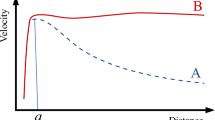Abstract
The peculiarities of the inverse square law of Newtonian gravity in standard big bang cosmology are discussed. It is shown that the incorporation of an additive term to Newtonian gravitation, as the inverse Yukawa-like field, allows removing the incompatibility between the flatness of the Universe and the density of matter in the Friedmann equation, provides a new approach for dark energy, and enables theoretical deduction of the Hubble–Lemaïtre law. The source of this inverse Yukawa-like field is the ordinary baryonic matter and represents the large-scale contribution of gravity in accordance with the Mach principle. It is heuristically built from a specular reflection of the Yukawa potential, in agreement with astronomical and laboratory observables, resulting null in the inner solar system, weakly attractive in ranges of interstellar distances, very attractive in distance ranges comparable to the clusters of galaxies, and repulsive in cosmic scales. Its implications in the missing mass of Zwicky, virial theorem, Kepler’s third law in globular clusters, rotation curves of galaxies, gravitational redshift, and Jean’s mass are discussed. The inclusion of the inverse Yukawa-like field in Newtonian gravitation predicts a graviton mass of at least 10−64 kg and could be an alternative to the paradigm of non-baryonic dark matter concomitant with the observables of the big bang.







Similar content being viewed by others
References
Adelberger E. G. et al. 2003, Ann. Rev. Nucl. Part. Sci. 53, 77
Arp H. 2003, Catalogue of Discordant Redshift Associations, Aperion: Montreal, Quebec, Canada, ISBN 0-9683689-9-9. https://ui.adsabs.harvard.edu/abs/2003cdra.book.....A/abstract
Bergshoeff E. et al. 2009, Phys. Rev. Lett. 102, 201301
Bondi H. 1951, Cosmology. Cambridge University Press, London
Chugreev Yu. V. 2017, Phys. Part. Nucl. Lett. 14, 539
Debono I., Smoot G. F. 2016, Universe 2, 23. https://doi.org/10.3390/universe2040023
de Jaege T. et al. 2020, A measurement of the Hubble constant from Type II supernovae. https://arXiv:2006.03412v2 [astro-ph.co]. https://arxiv.org/pdf/2006.03412.pdf
Einasto M. et al. 2011, The SLOAN great wall. morphology and galaxy content, arXiv:1105.1632 [astro-ph.CO]. https://arxiv.org/pdf/1105.1632.pdf
Evans R. F., Dunning-Davies J. 2004, The Gravitational Red-Shif, arXiv:0403082v1 [astro-ph.co]. https://arxiv.org/ftp/gr-qc/papers/0403/0403082.pdf
Event Horizon Telescope Collaboration 2019, J. Lett. 875, 1
Falcón N., Genova-Santos R. 2008, Exp. Fac. Sci. (Ciencia), 16, 323, http://produccioncientificaluz.org/index.php/ciencia/article/view/9868
Falcon N. 2011, Rev. Mex. Astron. Astrofis. 40, 11
Falcon N. 2012, Mecánica Clásica: Física Teórica en formalismos de Lagrange, Hamilton y Hamilton-Jacobi. Pub. Universidad de Carabobo: Valencia Carabobo Venezuela, ISBN 978-980-233-546-6. https://www.researchgate.net/profile/Nelson_Falcon/publication/234719996_MECANICA_CLASICA_Fisica_Teorica_en_formalismos_de_Lagrange_Hamilton_y_Hamilton-Jacobi/links/02bfe50ffceab22ea9000000/MECANICA-CLASICA-Fisica-Teorica-en-formalismos-de-Lagrange-Hamilton-y-Hamilton-Jacobi.pdf
Falcon N. 2013, J. Mod. Phys. 4, 10
Falcon N., Aguirre A. 2014, IJAA 4, 551
Gazeau J.-P., Novello M. 2011, IJMP 26, 3697
Genova-Santos R. T. 2020, The establishment of the Standard Cosmological Model through observations, arXiv:2001.08297v3 [astro-ph.CO]. https://arxiv.org/pdf/2001.08297.pdf
Harris W. E. 1996, Astron. J., 112, 1487 (2010 Edition)
Harris W. E. 2010, A new catalog of globular clusters in the Milky Way. https://arxiv.org/abs/1012.3224
Huterer D., Shafer D. L. 2018, Rep. Prog. Phys. 81, 016901 arXiv:1709.01091v2 [astro-ph.CO]
Kilic M. et al. 2017, ApJ 837, 162–171. https://iopscience.iop.org/article/10.3847/1538-4357/aa62a5/pdf
Kovács A. et al. 2016, Imprint of DES super-structures on the Cosmic Microwave Background, arXiv:1610.00637 [astro-ph.CO]. https://arxiv.org/pdf/1610.00637.pdf
Krauss L. et al. 2003, Science 299, 65
Laves K. 1898, Pop. Astron. 5, 513
LIGO Scientific Collaboration and Virgo Collaboration 2017, Phys. Rev. Lett. 118, 221101
Mach E. 1893, The Science of Mechanics. Cambridge University Press: Cambridge. https://fdocuments.in/document/e-mach-science-of-mechanicspdf.html
Milgrom M. 1983a, Astrophys. J. 270, 365
Milgrom M. 1983b, Astrophys. J. 270, 371
Peebles P. J. E., Rastra B. 2003, Rev. Mod. Phys. 75, 559
Perez L. et al. 2015, Acta Cient. Venezolana 66, 248
Perlmutter S. et al. 1999, Astrophys. J. 517, 565
Planck Collaboration Planck early results. VIII. 2011, A&A, 536, A8
Planck Collaboration. Planck 2015 Results. XIII. 2016, A&A, 594, A13
Planck Collaboration. Planck 2018 results. VI. 2019, Cosmological parameters, arXiv:1807.06209 [astro-ph.CO]. https://arxiv.org/pdf/1807.06209.pdf
Riess A. G. 2019, Astrophys. J., 876. https://doi.org/10.3847/1538-4357/ab1422
Riess G. et al. 1998, Astron. J. 116, 1009
Sabulsky D. O. et al. 2019, Phys. Rev. Lett. 123, 061102
Scarpa R. 2006, Modified Newtonian Dynamics, an Introductory Review, arXiv:0601478 [astro-ph.co]. https://arxiv.org/ftp/astro-ph/papers/0601/0601478.pdf
Shirmin G. I. 2016, Astron. Astrophys. Trans. 29, 313
Tremblay P. E. et al. 2014, White Dwarf Cosmochronology in the Solar Neighborhood, arXiv:1406.5173 [astro-ph.co]. https://arxiv.org/pdf/1406.5173.pdf
Trippe S. 2014, The Missing Mass Problem in Astronomy and the Need for a Modified Law of Gravity, arXiv:1401.5904 [astro-ph.CO]. https://arxiv.org/pdf/1401.5904.pdf
Wondrak M. F. 2017, The Cosmological Constant and its Problems: A Review of Gravitational Aethe, arXiv:1705.06294 v1[astro-ph.co]
Zwicky F. 1933, Helv. Phys. Acta 6, 110
Author information
Authors and Affiliations
Corresponding author
Appendix
Appendix
1.1 Additional note about the virial theorem
Beginning with the Clasius’s virial expression, we have:
The term within the integral is a continuous function, whose domains are all real numbers, differentiable on the interval (0, τ) and bounded by 1 and f(α), then follow with (38).
Rights and permissions
About this article
Cite this article
FALCON, N. A large-scale heuristic modification of Newtonian gravity as an alternative approach to dark energy and dark matter. J Astrophys Astron 42, 102 (2021). https://doi.org/10.1007/s12036-021-09752-0
Received:
Accepted:
Published:
DOI: https://doi.org/10.1007/s12036-021-09752-0




